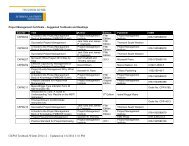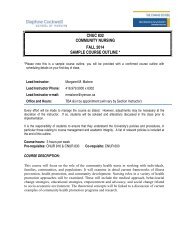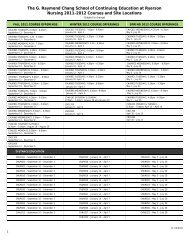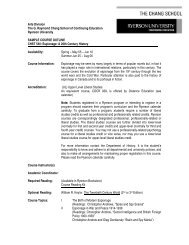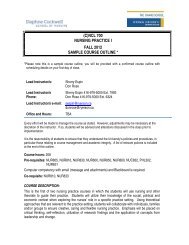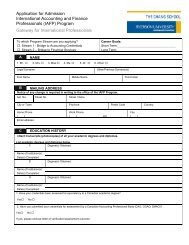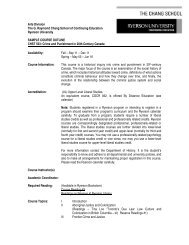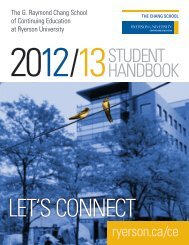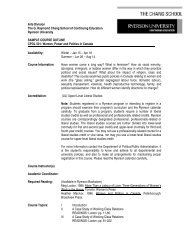EnrollmentConfirmation of EnrollmentOnlineYou will be able to check your enrollment online atmy.ryerson.ca. Click on the RAMSS tab for your class schedule.In-PersonYour fees receipt will be issued upon payment of your tuitionfee at the Enrollment Services and <strong>Student</strong> Fees office. Nofurther statements of confirmation will be mailed to you.By MailIf you meet the enrollment deadlines, you will receive yourconfirmation by email.<strong>Student</strong>s are academically and financially responsible forall enrolled courses and fees incurred unless they formallywithdraw in writing or online via RAMSS by the appropriateUniversity deadline dates (whether or not they attend a class).Enrollment FAQ1. Are all courses scheduled every term?No; all courses are not scheduled every term. Check Coursesand Programs to plan ahead to ensure that you will be ableto take the courses you need/want.2. What is an Interview or Placement Assessment, and how do Ifind out if the course I’m planning to take requires one?Some courses require an interview and/or placementassessment before you can enroll. See Interviews andPlacement Assessments for a list of affected programs.3. What is an Open House session, and how do I find out if thecourse I’m planning to take has one?Open House sessions are free events that give you anopportunity to meet with course and program representativesin a one-to-one or small group setting. Open Housesessions are associated with programs, so consult Coursesand Programs to find out what program the course you’reinterested in is part of. <strong>The</strong>n see Open House for detailsand dates.4. What are prerequisites, precursors, and corequisites?Prerequisite means that you must pass Course A before takingCourse B. <strong>The</strong> course description in Courses and Programswill tell you what prerequisites, if any, are required.Precursor means that you must have taken Course A beforetaking Course B, but you do not have to pass Course A beforetaking Course B. You must, however, pass Course A to qualifyfor a certificate, diploma, or degree.Corequisite means that you must take Course A prior to, orconcurrently with, Course B.5. How do I find out if a course has any specific admissionprerequisites?Check the course description in Courses and Programsto see if it has specific admission prerequisites. You canalso speak to the program coordinator at an Open Housesession, or drop into <strong>The</strong> G. Raymond <strong>Chang</strong> <strong>School</strong> ofContinuing Education office (Heaslip House, 297 VictoriaStreet). In some cases, your prior professional experiencemight serve as a substitute for a prerequisite. In other cases,you may be asked to provide transcripts, and possibly coursedescriptions or outlines of courses taken elsewhere thatmay also fill the prerequisite requirement. If the programcoordinator is unable to resolve your situation, you mightbe referred directly to Admissions for formal assessmentand resolution.See also Academic Bridging Courses to find out how youcan fill the prerequisite requirements you need in order tobe considered for admission to a <strong>Chang</strong> <strong>School</strong> certificateprogram. Note: Academic Bridging Courses are continuingeducation equivalents, and do not count as Grade 12 Ucourses or high school credits. <strong>The</strong>y cannot be used towardsobtaining an Ontario Secondary <strong>School</strong> Diploma (OSSD).6. What do I do if I don’t have my Grade 12 U Courses?Sometimes students are not accepted into the <strong>Ryerson</strong>’sfull-time degree programs because they don’t have all therequired Grade 12 U (or high school equivalency) courses.This doesn’t mean you have to go back to high school –<strong>The</strong> G. Raymond <strong>Chang</strong> <strong>School</strong> of Continuing Educationoffers Grade 12 U-level courses in English, mathematics,chemistry, biology, and physics during the evenings. For moreinformation on scheduling, see Academic Bridging Courses.Note: Academic Bridging Courses are continuing educationequivalents, and do not count as Grade 12 U courses or highschool credits. <strong>The</strong>y cannot be used towards obtaining anOntario Secondary <strong>School</strong> Diploma (OSSD).7. Where do I find a course’s start and end dates?<strong>The</strong> course description for each course listed in Courses andPrograms includes the course’s start and end dates for eachof the terms in which it is offered. Note that if the coursedescription is lengthy, you might have to scroll down the pageto find the table of times and dates.8. Is space available in the course I’m planning to take?In Courses and Programs, course availability is indicated ona real-time basis for terms open for enrollment.9. Is financial aid available to help me pay my tuition fees?See Awards and Financial Aid for detailed information aboutmerit-based awards and need-based bursaries and governmentassistance available to <strong>Chang</strong> <strong>School</strong> students.10. Can I get OSAP for continuing education courses?It is possible to receive government assistance to study through<strong>The</strong> G. Raymond <strong>Chang</strong> <strong>School</strong> of Continuing Education.Please note, however, that restrictions do apply. First, youmust be registered in an approved certificate program and youmust be taking at least 60 percent of a regular course load.For complete details and the most up-to-date information onOSAP, contact the <strong>Student</strong> Financial Assistance office.11. How do I pay my course fees?See Fees to find information about how and when to pay, feerates, fee policies, ancillary fees and service charges, refunds,and more. All fees must be paid in full at time of enrollment.Any students with outstanding fees will be required to cleartheir debt before any further enrollments are processed.International <strong>Student</strong>s: After enrolling and paying foryour course, you are required to obtain a valid Study Permitfrom Citizenship and Immigration Canada for your period ofstudy if your studies will last longer than six months. ContactInternational <strong>Student</strong> Services for more information.12. Where can I find information about important dates suchas enrollment periods, withdrawal, transfer, and grade appealdeadlines?Important Dates lists important dates for the Fall, Winter,and Spring terms.13. Where can I find out about <strong>Ryerson</strong>’s formal policies on issuessuch as refunds, withdrawals, transfers, letters of permission,grades, and appeals?See Policies to familiarize yourself with important policyinformation before enrolling.14. When do I enroll for the course I’m planning to take? Is therea cut-off date?Enrollment periods are listed on the Important Dates page.You can enroll in courses right up until the time the coursestarts; but remember, courses are available on a first-come,first-served basis. Many of our courses are very popular andfill up long before the start date of classes so it’s best to enrollas soon as you’ve made up your mind.15. Should I register in a certificate program as well as in mychosen courses?On your resumé, saying that you have successfully completeda certificate in a coherent program of study can crediblydemonstrate a fully developed skill. If you’re pretty sure youwould like to complete a certificate, it’s wise to register assoon as possible. See Registration in a Certificate Programfor more information.One other advantage of being a certificate student is thatyou will have priority enrollment privileges in the future. Thismeans that before each new term, for a specified period oftime, certificate students are able to enroll in courses beforeany other new or returning students. Also, only courses takenAFTER registration in the certificate will be included in yourgrade point average (GPA), although you will still receivecredit for any previous courses you’ve taken.You MUST register in a certificate program before youfinish 50 percent of the program’s course requirements.16. How can I find out where my classes will be held?Look up the location of your classroom and your instructor’sname on Classroom Lookup (Note: locations are not finalizeduntil 3:00 p.m. the first day of class). On the evening of yourfirst class of the term, lists of the locations of all classesto be held that night will be posted in the lobbies of theLibrary Building and Heaslip House. Please note your sectionnumber to avoid going to the wrong room. It’s a good ideato arrive on campus 10 or 15 minutes earlier than normalthat night because you might spend a little time finding yourclassroom.17. How can I find out which texts to buy?On the first night of class, your instructor will provide acourse outline detailing course content, assignments,evaluation break-down, and a list of the required texts andmaterials. Often during this first class, time is taken out toensure you can get to the <strong>Ryerson</strong> University Campus Storethat evening before it closes. Unless you are enrolled in aweek-long intensive course that requires advance preparation,you will not be expected to have prepared anything for thefirst class.18. How do distance education students find out which texts tobuy, and how do they order them?Distance education students can access information aboutcourse materials specific to the course they are taking at theDistance Education Course Materials page. <strong>Student</strong>s can thenorder and purchase the materials online through the <strong>Ryerson</strong>University Campus Store or they can visit the campus storeand purchase the materials in person.Enrollment10 For the most current information, see our website at www.ryerson.ca/ce. <strong>The</strong> <strong>Chang</strong> <strong>School</strong> <strong>Student</strong> <strong>Handbook</strong> <strong>2013</strong>–<strong>2014</strong> 11
Enrollment<strong>Ryerson</strong> Study Weeksat <strong>The</strong> <strong>Chang</strong> <strong>School</strong> FAQIn May 2011, the <strong>Ryerson</strong> Senate passed a motion introducinga Fall Study Week; as a result, <strong>Ryerson</strong> University haschanged from a 13-week term to a 12-week term (except forEngineering) to accommodate the break in both the Fall andWinter terms. This has resulted in a number of other changesat <strong>Ryerson</strong> and <strong>The</strong> <strong>Chang</strong> <strong>School</strong>.1. What is a “12-week term”?A 12-week term consists of 12 weeks of classroom sessions,with an additional week set aside at the end of the term forthe final examination or other final assignments.2. How many course hours will the 12-week term involve?Course durations will be adjusted to match the new 13-weekschedule. For example, 56-hour courses will become 52-hourcourses, 42-hour courses will become 39-hour courses, and21-hour courses will become 19.5-hour courses. Programsoffered by Gateway for International Professionals, Programsfor 50+, Spanning the Gaps, and workshops offered by allprogram areas will be reviewed and adjusted if required andas appropriate. See Question 4 for further information aboutexceptions.3. When are the Study Weeks for <strong>Chang</strong> <strong>School</strong> students?<strong>The</strong> <strong>Chang</strong> <strong>School</strong> will observe both of the <strong>Ryerson</strong> StudyWeeks:▸▸Fall Study Week: Thanksgiving week, October 12,<strong>2013</strong>–October 18, <strong>2013</strong>; classes resume October 19, <strong>2013</strong>▸▸Winter Study Week: Family Day week, February 15, <strong>2014</strong>–February 21, <strong>2014</strong>; classes resume February 22, <strong>2014</strong>▸▸Most classes will not run during these weeks.4. Which <strong>Chang</strong> <strong>School</strong> courses will run during the Study Weeks?Some types of course delivery modes, such as half-termcourses, intensive courses, accelerated courses, andworkshops, may not observe these Study Week breaks due totheir condensed schedules. Consult individual courses listingson the <strong>Chang</strong> <strong>School</strong> website for specific information aboutcourse durations and dates, or consult the course outlineprovided by your instructor.5. Are distance education courses affected by the Study Weeks?Yes. Full-term distance education courses will observe theStudy Week breaks unless otherwise noted. Accelerated andhalf-term distance education courses will run through theStudy Weeks. Please check the individual course listing oryour course outline to see the exact schedule for your course.6. Have start dates for <strong>The</strong> <strong>Chang</strong> <strong>School</strong>’s terms changed?Classes for <strong>The</strong> <strong>Chang</strong> <strong>School</strong>’s Fall term will start during thesecond week of September, one week later than the <strong>Ryerson</strong>Fall term, with a few exceptions. Classes for <strong>The</strong> <strong>Chang</strong><strong>School</strong>’s Winter term will start during the second week inJanuary (no change), which will align <strong>Chang</strong> <strong>School</strong> classeswith the start of the <strong>Ryerson</strong> Winter term. Classes for theSpring/Summer terms will start during the first week in May(no change). Please check the <strong>Chang</strong> <strong>School</strong> website for theexact schedule for your course.7. Is the cost per course less, considering hours are nowreduced?<strong>The</strong>re are no changes in the course fees. <strong>The</strong> courses willcover the same content as in the past, but the instructors willbe using different approaches to present the material in orderto accommodate the new term structure.ESL/EAL Online Placement TestMany English as a Second/Additional Language coursesrequire an online placement test prior to enrollment.Interested students can access this test online to determinethe appropriate level of study.1. Go to www.ryerson.ca/french/englishtest.html.2. Complete all sections of the online test.3. You will receive an email within five business days withyour course placement. (Note: During the months ofJuly and August, the ESL/EAL Online Placement Testresponse time will be up to 10 business days).4. Print the email and bring it to Enrollment Services and<strong>Student</strong> Fees to enroll in your course(s).5. Take a copy of the course placement email to yourfirst class.Course FeesFees are noted at the end of each course description inCourses and Programs. Fees are quoted in Canadian fundsand are the Regular Fee Rate and International Fee Rate.You pay your fees when you make your application to enroll,whether you enroll online, by mail, or in person.Enrollment provides detailed information about theenrollment process.For fee payment procedures, see Payment of Fees. See alsoFee Policies, Non-Tuition Related Fees and Services Charges,Refunds, and Income Tax Receipts. Part-time degree studentsshould refer to the Undergraduate Calendar.Can I get financial assistance to help pay my fees?Awards and Financial Aid lists all need-based financial aid(including government assistance) and merit-based awardsavailable to continuing education students, along with eligibilitycriteria, how to apply, application deadlines, and more.What are international student fees?International <strong>Student</strong>s explains how to calculate theInternational Fee Rate for courses. It also provides additionaldetails about services and information for international students.International <strong>Student</strong>s: <strong>Ryerson</strong> University is currentlyunable to offer financial assistance to international continuingeducation students. All international students are encouragedto explore home government or private sources of fundingprior to arriving in Canada.Full-Time <strong>Student</strong>s: <strong>Ryerson</strong> Undergraduate full-timeprogram students who enroll in continuing education coursesthrough <strong>The</strong> <strong>Chang</strong> <strong>School</strong> will be charged the applicable<strong>Chang</strong> <strong>School</strong> course fee(s).Non-Tuition Related Feesand Service ChargesFees for all continuing education students include ancillaryfees and may also include additional charges:▸▸material fees▸▸late fee service charges▸▸NSF cheques/denied credit card authorization feesFees on Behalf of <strong>Student</strong> Groups and Third PartiesCanadian Federation of <strong>Student</strong>s (CFS) FeeA fee of $2.38 per student, per course enrollment, is levied forthe Canadian Federation of <strong>Student</strong>s.Continuing Education <strong>Student</strong>s’ Associationof <strong>Ryerson</strong> (CESAR) FeeA fee of $12.08 per student, per course enrollment, is collectedby the University on behalf of CESAR for all courses of 30hours duration or more. Course fees have been adjusted,where appropriate, to include this fee.Oakham House FeeA fee of $1.00 per student, per course enrollment, is leviedfor Oakham House support and is included in the course fee.This fee is assessed against all courses for which the CESARfee applies.<strong>Student</strong> Campus Centre Development FundA fee of $0.50 per student, per course enrollment, is levied insupport of the student centre.University FeesAccess Copyright FeeA fee of $2.60 per student, per Continuing Education creditcourse, is levied for copyright material fees.Access Campus Centre FeeA fee of $2.50 per student, per course enrollment, is levied insupport of the student centre.<strong>Student</strong> Services FeeA fee of $6.32 per student, per course enrollment, is leviedfor <strong>Student</strong> Services.Recreation and Athletics Centre (RAC) FeeA fee of $0.50 per student, per course enrollment, is leviedfor RAC capital support and is included in the course fee.This fee is assessed against all courses for which the CESARfee applies.Material FeesIn some courses a portion of the total course tuition fee includesa material fee for learning material or clothing retained by thestudent. For the refund policy that applies to these courses,please refer to the Material Fees note under Refunds.Late Fee Service Charges<strong>The</strong>re is a late fee service charge of 1.25% per month (16.08%effective annual rate) assessed on any unpaid balance in astudent’s account.NSF Cheques/Denied Credit Card AuthorizationAny student who tenders a cheque or uses a Visa, MasterCard,or American Express credit card which is subsequently nothonoured by the banking institution will be charged $50 bythe Enrollment Services and <strong>Student</strong> Fees office. Paymentfor outstanding fees plus the $50 must be made by certifiedcheque or money order, payable to <strong>Ryerson</strong> University.Fee Policies<strong>Chang</strong>esEvery effort is made to adhere to the details outlined on thiswebsite, although courses, fees, days, hours of instruction,and instructors are subject to change without prior notice.Note: Fees charged by <strong>Ryerson</strong> are approved annually bythe Board of Governors for an academic year. <strong>Ryerson</strong> reservesthe right to make changes in both the fees and procedureswithout prior notice.<strong>Student</strong>s are academically and financially responsible forall enrolled courses and fees incurred unless they formallywithdraw in writing or online via RAMSS by the appropriateUniversity deadline dates (whether or not they attend a class).HSTSome courses are subject to HST and where applicable it isincluded in the total fee. Course fees that contain HST have“Tax Included” noted beside the fee.Outstanding Fees and CostsAs a student, you are personally responsible for paying thefollowing:▸▸library fines▸▸fees for services rendered▸▸costs incurred for damage to, or loss of, UniversitypropertyNon-payment of fees/costs will result in the withholdingof grades and transcripts, issuance of official Universitydocumentation, ineligibility for enrollment, and any otheraction deemed appropriate by the University. <strong>Ryerson</strong> cannotbe held responsible for debts incurred by individual studentsor student organizations.If you have any outstanding fees owed to <strong>Ryerson</strong>,any payment will first be applied to the existing balance.Enrollment for courses in the next term is not permitted ifthere is any outstanding fee balance.Enrollment12 For the most current information, see our website at www.ryerson.ca/ce. <strong>The</strong> <strong>Chang</strong> <strong>School</strong> <strong>Student</strong> <strong>Handbook</strong> <strong>2013</strong>–<strong>2014</strong> 13



